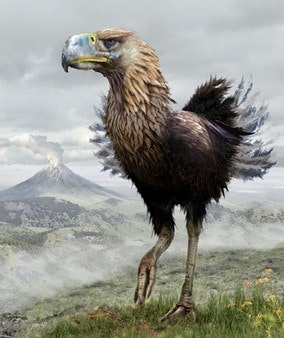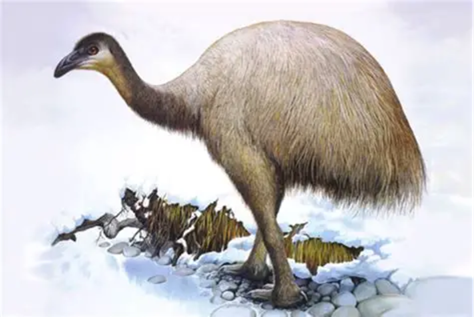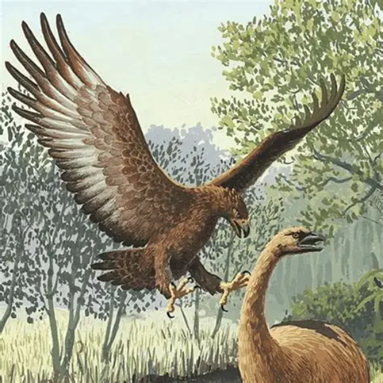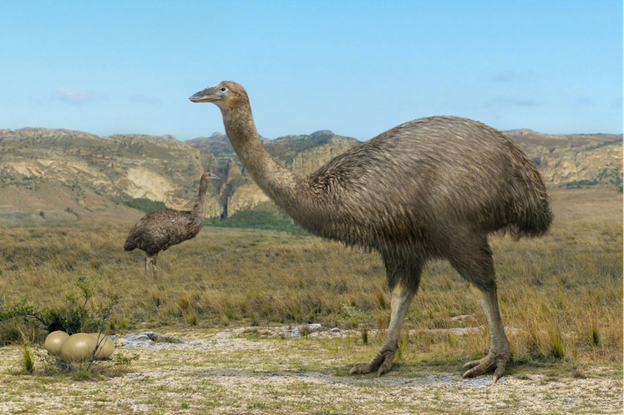Giants of the Sky: Terror Birds and Moas
By Ranger Doug Sousa
As a kid, I was fascinated with dinosaurs. I could entertain myself for hours playing with the plastic replicas of these prehistoric creatures. I’ve enjoyed watching my own children discover and learn about dinosaurs and prehistoric birds as well! As I planned my upcoming nature program, scheduled for the weekend before Thanksgiving, thoughts of turkeys led me to wonder about the traits these and other birds still possess today from their ancestors of long ago.

Teeth and Claws on the Wing
Roughly 150 million years ago, while dinosaurs ruled the Earth, small winged, feathered creatures began to appear. Evolving from the theropod lineage of dinosaurs, which also included raptors and Tyrannosaurus rex, these early birds often retained teeth and claws on the ends of their wings. These early aviators would glide or fly through the prehistoric canopy, hunting small dinosaurs, mammals, or lizards. From these early beginnings to the present day, these winged marvels have both amazed and sometimes terrified us and our ancient ancestors.
Large Skulled Terror Birds
Shortly after the dinosaurs died off, a void of large predators was left across the globe. About 62 million years ago, in South America, a new apex predator emerged: the terror birds. These large, flightless birds stalked the countryside in search of prey. The largest of the terror birds evolved about 15 million years ago in what is now Argentina.

At 10 feet tall and estimated to weigh 650 pounds, the Kelenken guillermoi was the largest terror bird ever discovered. With long, powerful legs, this true terror was built for speed. It is estimated that this bird can run at speeds of up to 40 mph. At the end of its long neck sat a large skull with a heavy beak. In fact, it is the largest bird skull ever discovered, larger than even some horse skulls! This creature’s head was over 2 feet in length, and scientists believe that they would have used this skull like an axe on smaller, slower prey. Like birds of prey today, it is thought that this terror bird would have ripped off chunks of flesh and swallowed them whole!
The Wingless New Zealand Moa
Roughly around the same time that the massive terror birds were dominating South America, another large bird species was beginning its journey on an island halfway around the world. The Moa was so dominant at its peak that it filled many niches on its island home.

While nine species of Moa were found throughout the fossil record, a few stood out. The smallest Moa was roughly the size of a turkey, but one of the Moa was possibly the largest bird to ever exist on planet Earth.
The South Island Giant Moa was a true Goliath. Once native to what is now New Zealand, these Moa were upwards of 12 feet tall and could weigh up to an impressive 550 lbs!
Researchers have studied Moa coprolites (fossilized poop) and discovered that their diet consisted of grasses, twigs, berries, leaves, herbs, and ferns.
Without pressure for resources from large mammalian herbivores, the Moa filled the niche as the island's top herbivore. In fact, the Moa were so specialized as grazers and were so dominant on the island that they lost the ability to fly entirely. They evolved to become wingless, lacking even vestigial wings.
New Zealand had been isolated for roughly 80 million years before humans arrived on the island. The Moa had not evolved to deal with terrestrial predators and had little ability to overcome the pressures introduced by humans after their arrival. Through carbon dating, it is believed that humans completely eradicated the Moa in just 100 years.
The Hasst’s Eagle: Moa’s Only Predator
The Moa’s only predator (before humans arrived in New Zealand) was another large prehistoric bird called the Haast’s Eagle. This giant eagle was the apex predator in New Zealand. This Eagle had a 10-foot wingspan, which, while quite large, was small for its body size. Researchers suggest that this smaller wing-to-body ratio may have enabled it to zip through the thick vegetative canopy of prehistoric New Zealand in search of its preferred prey. Not only did it have a large wingspan, but its body was heavy.

It is thought that the Haast’s Eagle was double the weight of the largest Eagle alive today, the Harpy Eagle. Massive talons would have helped it hold on to such large prey. Fossils show us that the talons could reach 3 1/2” in length. It is believed that the eagle was capable of taking down large prey with precision strikes. Current theories believe that the eagle would have dove at speeds up to 50 mph and aimed for the much larger birds’ back and neck. This impact on the spine, coupled with its large talons, could have been a deadly combination.
Having evolved to hunt the giant Moa, the Eagle faced co-extinction when they were outhunted by the new bipedal predators that arrived on their island.
Madagascar Elephant Bird – A Gentle Giant
At roughly the same time, on an island off the coast of Africa lived another colossal bird, the Elephant bird. While this bird was not as tall as its cousin, the Moa, it was much, much heavier. This bird is believed to be around 10 feet tall and weigh up to an astonishing 2,200 lbs. Like the Moa, the Elephant bird was the most prolific herbivore on what is today known as Madagascar.

The Elephant bird was a titan throughout its life. An elephant bird egg was larger than an official NBA basketball and weighed a hefty 22 lbs. Even Steph Curry would have problems shooting that thing! It is currently believed that these monsters were also nocturnal. In 2018, scientists CT-scanned Elephant bird skulls. They noticed that their optic lobes (the part of the brain that processes vision) were very small, similar to those of the nocturnal kiwi bird. This may have reduced competition from other grazers. It was believed that they were truly gentle giants.
Much like the amazing mammals and dinosaurs from the past that get so much of our collective attention, the birds of the past were truly astonishing as well. Whether they lumber, fly, or sprint, these feathered wonders should not be lost to the ground beneath our feet but live on in our imagination.
How Prehistoric Birds Influenced Today's Turkey and Other Feathered Creatures at Sycamore Grove Park.
Join me for a Prehistoric Bird nature program about these creatures and how their evolution influenced modern-day birds next month: Prehistoric Birds and the Modern-Day Turkey
Image Credits:
- Reddit.com, Pinterest.es, erranature.com, japandreamscapes.com, https://en.meteorologiaenred.com/elephant-bird.html
